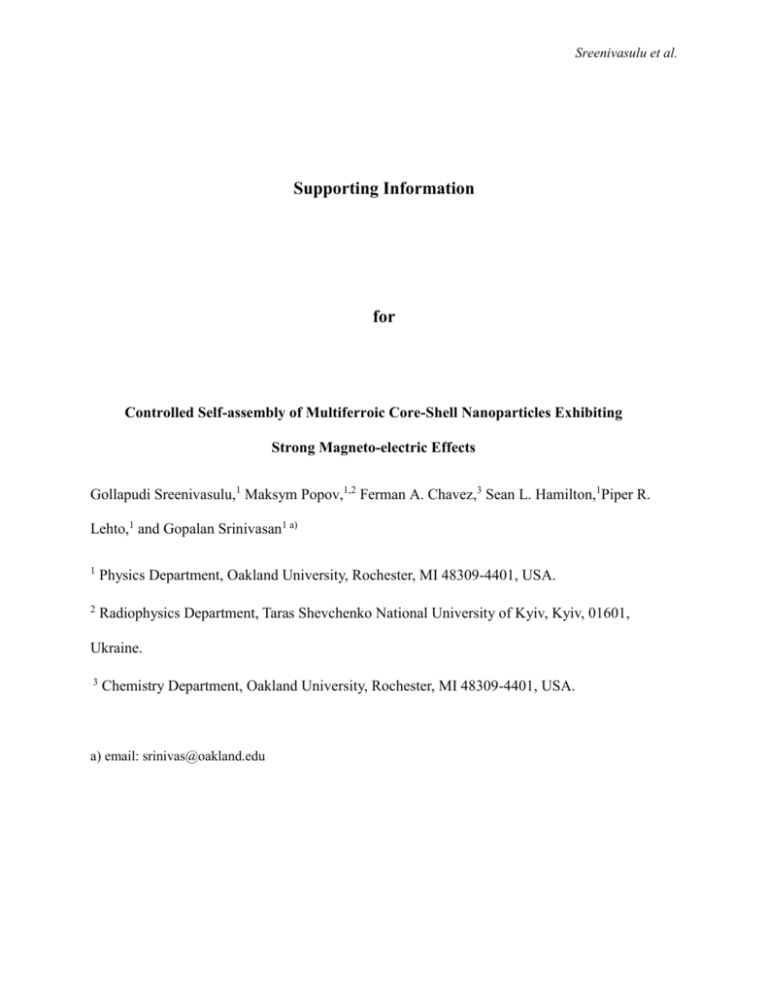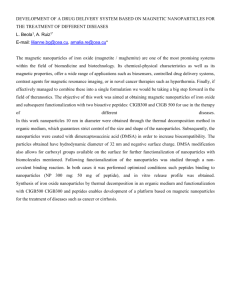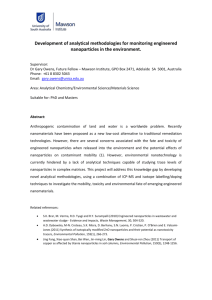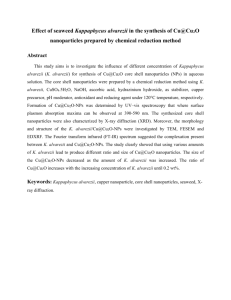Supplementary online information
advertisement

Sreenivasulu et al. Supporting Information for Controlled Self-assembly of Multiferroic Core-Shell Nanoparticles Exhibiting Strong Magneto-electric Effects Gollapudi Sreenivasulu,1 Maksym Popov,1,2 Ferman A. Chavez,3 Sean L. Hamilton,1Piper R. Lehto,1 and Gopalan Srinivasan1 a) 1 Physics Department, Oakland University, Rochester, MI 48309-4401, USA. 2 Radiophysics Department, Taras Shevchenko National University of Kyiv, Kyiv, 01601, Ukraine. 3 Chemistry Department, Oakland University, Rochester, MI 48309-4401, USA. a) email: srinivas@oakland.edu Sreenivasulu et al. Experimental Materials Trifluoromethanesulfonic anhydride, propargyl alcohol, 3-buten-1-ol, methanesulfonyl chloride, silica gel (60, 0.0320.063 mm, 230−400 mesh), sodium L-ascorbate were procured from Alfa Aesar. Trimethyl citrate and sodium azide were obtained from Sigma-Aldrich. Copper(II) acetate tetrahydrate, triethylamine, sodium sulfate (anhydrous) were purchased from Acros. Ethyl acetate, hexanes, and DMSO were obtained from Mallinckrodt. O-propargyltrimethyl citrate was prepared as described in the literature,1 Tris(3-hydroxypropyltriazolylmethyl)-amine was prepared by a known method.2 Dichlormethane, THF, DMF, and ether were purified using an Innovative Technologies, Inc. solvent purification system. Methanol (Fischer) was used as received. Pyridine (Alfa Aesar) was distilled from CaH2. A Milli-Q water purification system (Millipore Corporation) was used to generate purified water. Synthesis Prop-2-ynyl trifluoromethanesulfonate. This compound was prepared according to a modified literature method.3 Trifluoromethanesulfonic anhydride (44 mL, 0.262 mol) was dripped slowly into a stirring solution of dry pyridine (21.1 mL, 0.262 mol) in methylene chloride (600 mL) at 40 °C (acetonitrile/dry ice) under nitrogen. Neat propargyl alcohol (14.7 mL, 0.255 mol) was added dropwise over a 15 min period. The suspension was allowed to warm and filtered through a medium sintered glass funnel containing a pad of celite. The dichloromethane was removed in vacuo and the resultant oil was extracted with pentane (3 x 50 mL). The pentane was filtered through 1:1 w/w celite:anhydrous sodium sulfate and then removed in vacuo. The product was Sreenivasulu et al. isolated by fractional distillation (bath temperature: 40 °C, 60 mmHg). Yield: 18.0 g (26%). The colorless oil was stored at 70 °C. Spectroscopic characterization matched published values.3 O-propargyl citric acid. 767 mg (2.82 mmol) O-propargyltrimethyl citrate was refluxed in 56 mL 2.4 M HCl for 3 h. The solution was vacuum distilled keeping the solution temperature below 100 °C. The sample was then placed under high vacuum overnight at 25 °C. Yield: 606.4 mg (93%). Spectroscopic characterization matched published values.1 Functionalization of Nanoparticles. Azide modification was achieved using a procedure similar to that reported elsewhere.4 The 10-100 nm NFO nanoparticles prepared by co-precipitation and (vendor supplied) BTO particles were immersed in 3-buten-1-ol and then sealed in a nitrogenfilled quartz cuvette. The cell was mechanically agitated while it was exposed to ultraviolet (UV) light (254 nm, ∼15 mW/cm2) for 17 h to graft the 3-buten-1-ol molecules to the nanoparticle surface via the alkene group. The samples were then rinsed sequentially with MeOH, CHCl3, and iPrOH. The terminal OH groups were converted to methanesulfonyl (mesyl) groups by immersing the sample in a 10:1 (by volume) CH2Cl2:triethylamine at 0 °C then adding methanesulfonyl chloride (1 volume) and allowing the mixture to sit for 1 h at 0 °C. After rinsing with CH2Cl2, MeOH, and iPrOH the mesyl groups were converted to azide groups by immersing the sample in a solution of supersaturated NaN3 in DMSO for 15 h at 80 ºC. Rinsing with deionized water for one minute followed by iPrOH resulted in azide-modified nanoparticles. Successful functionalization was verified using FTIR (KBr pellet) spectroscopy. The appearance of absorbance bands that are characteristic of azide-bound onto the nanoparticles were not clearly observed between 13801620 cm1 due to overlap with peaks already present in the Sreenivasulu et al. unfunctionalized nanoparticles. A peak at 2036 cm1, however, was clearly observed in the FTIR spectra in Figure 1(b) and is known to be associated with the azide group.1 Functionalization of NFO or BTO nanoparticles with O-propargyl citrate groups was accomplished by mixing Opropargylcitric acid1,3 (10 mM in MeOH) with the nanoparticle suspension in methanol. In a typical reaction, 120 mg of O-propargylcitric acid was dissolved in 60 mL methanol and added to 3 g of BTO. The mixture was ultrasonicated for 1.5 h and then centrifuged using a benchtop centrifuge. The supernatant was decanted and the pellet was washed with fresh methanol. Attachment of the O-propargyl citrate groups was verified using FTIR (KBr pellet) spectroscopy. The appearance of absorbance bands that are characteristic of O-propargyl citrate bound onto the nanoparticles was observed at 1570 and 1412 cm-1 in the FTIR spectra.1 CuAAC reaction between functionalized nanoparticles. This was carried out as follows: In one experiment, 75 mg each of alkyne modified BTO (50 nm) and azide modified NFO (10 nm) along with100 mg of sodium ascorbate were placed in 15 mL of water. To this was added 4.4 mg of copper(II) acetate tetrahydrate and 10 mg of tris[(1-benzyl-1H-1,2,3-triazol-4- yl)methyl]amine2 (Cu/TBTA) solution in 10 mL DMSO. This solution was sonicated for 15 min and allowed to sit at 25 °C for 15 h. The samples were then sequentially rinsed with deionized water, MeOH, and iPrOH and dried. Sreenivasulu et al. References 1. L. M. Bishop, J. C. Yeager, X. Chen, J. N. Wheeler, M. D. Torelli, M. C. Benson, S. D. Burke, J. A. Pedersen, and R. J. Hamers, Langmuir 2012, 28, 1322. 2. V. Hong, S. I. Presolski, C. Ma, and M. G. Finn, Angew. Chem. Int. Ed. 2009, 48, 9879. 3. E. Vedejs, D. A. Engler, and M. J. Mullins, J. Org. Chem. 1977, 42, 3109. 4. A. C. Cardiel, M. C. Benson, L. M. Bishop, K. M. Louis, J. C. Yeager, Y. Tan, and R. J. Hamers, ACS Nano 2012, 6, 310.








